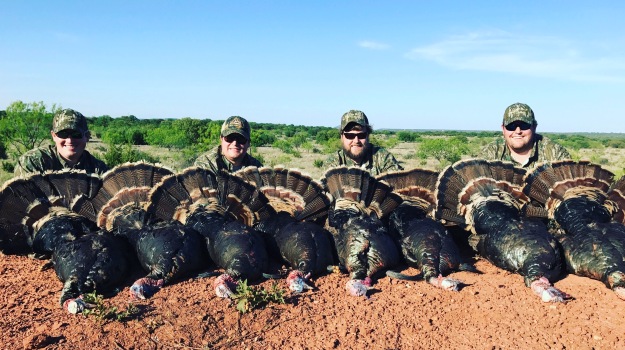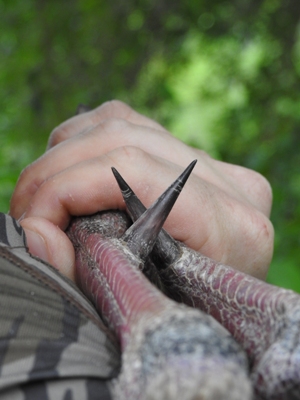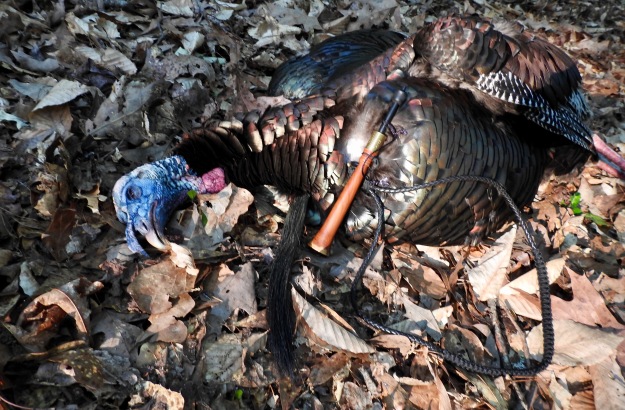with Calvin Perryman

The last turkey I took in Alabama’s 2017 turkey season was an afternoon gobbler. In Alabama, we can hunt all day long during turkey season. So, I was out driving around looking for turkeys in a field that I planned to hunt the next morning. When I saw a gobbler with some hens out in a field, I decided to go after him.
Since I had all my turkey hunting gear with me, I parked my car where the turkey couldn’t see it, slipped into the woods and set up about 200 yards from the gobbler and his hens. I yelped and the turkey gobbled. But he wasn’t in the same place he’d been when I had seen him with my binoculars. He was in the woods on the other side of the field from where I had spotted him from the road. I knew the turkey couldn’t see me, because there was a lot of thick brush between me and the edge of the field. So, I used that thick brush to cover my movements until I reached the edge of the field. I got set up, and the turkey gobbled a couple more times after I yelped.
 I know that many hunters would have set up decoys on the edge of that field to give the gobbler what he thought to be other turkeys to look at once he started to come in to where I was. I've seen decoys work. However, I've also seen decoys spook a lot of turkeys. I know that a strutting decoy will pull in an older-age gobbler like the one I was hunting. Many times if you put out a big strutting decoy, and you're working 2-year-old birds, generally they’ll run from a strutting decoy. I don’t use decoys, because I don’t want to carry any more gear than I have to.
I know that many hunters would have set up decoys on the edge of that field to give the gobbler what he thought to be other turkeys to look at once he started to come in to where I was. I've seen decoys work. However, I've also seen decoys spook a lot of turkeys. I know that a strutting decoy will pull in an older-age gobbler like the one I was hunting. Many times if you put out a big strutting decoy, and you're working 2-year-old birds, generally they’ll run from a strutting decoy. I don’t use decoys, because I don’t want to carry any more gear than I have to.
When this big gobbler was at 40 yards, I squeezed the trigger on my little 20 gauge, and the big tom bit the dust. That gobbler had 1-1/2-inch spurs and was an old gobbler. Maybe a big strutting decoy could have brought him to within gun range. Since he had hens with him, he may have led those hens away from that big strutting decoy. Because I don’t always know whether I'm calling in young gobblers or old gobblers, I just prefer not to use decoys.
In between my Alabama hunts, I made a trip to Texas with some friends to hunt Rio Grande turkeys. I had already taken three gobblers in Alabama before the Texas trip. Some buddies of mine from college and I always talked about going to Texas to hunt Rio Grande gobblers, but we’d never had the opportunity. One of my friends knew a rancher in Texas who had some Rio Grande gobblers on his property, so we decided that we would make the trip in 2017.
On my Texas hunt, I learned that Rio Grande turkeys, at least the ones where we hunted, were much different birds than the eastern gobblers we hunted in Alabama. The Rio Grande gobblers responded to calls much better than the Alabama gobblers did. Those birds also gobbled all day long. Although I wouldn’t classify Rio Grande gobblers as easy to harvest, they were much easier to take than Alabama’s eastern gobblers.
One of the aspects of the Texas hunt that I really enjoyed was we could hear 15 or more turkeys gobble each morning we went out to hunt. In Alabama, you're lucky to hear one to three turkeys gobble in a morning. On the property we hunted, the landowner would let us take two gobblers each. My buddy Carter Weeks and I each harvested a turkey on the first afternoon. On the second afternoon of the hunt, I took my second Texas bird. The birds we harvested seemed to be older turkeys that had 1-inch to 1-1/2-inch spurs. The Texas turkeys were much heavier than Alabama gobblers with several weighing 24 – 25 pounds each.






























